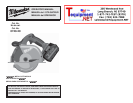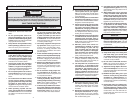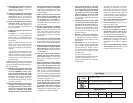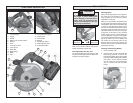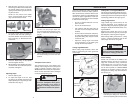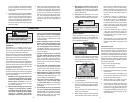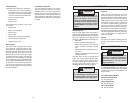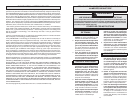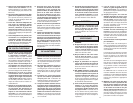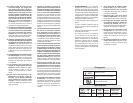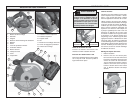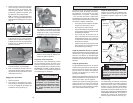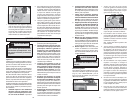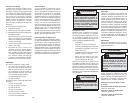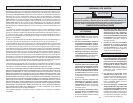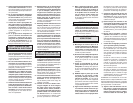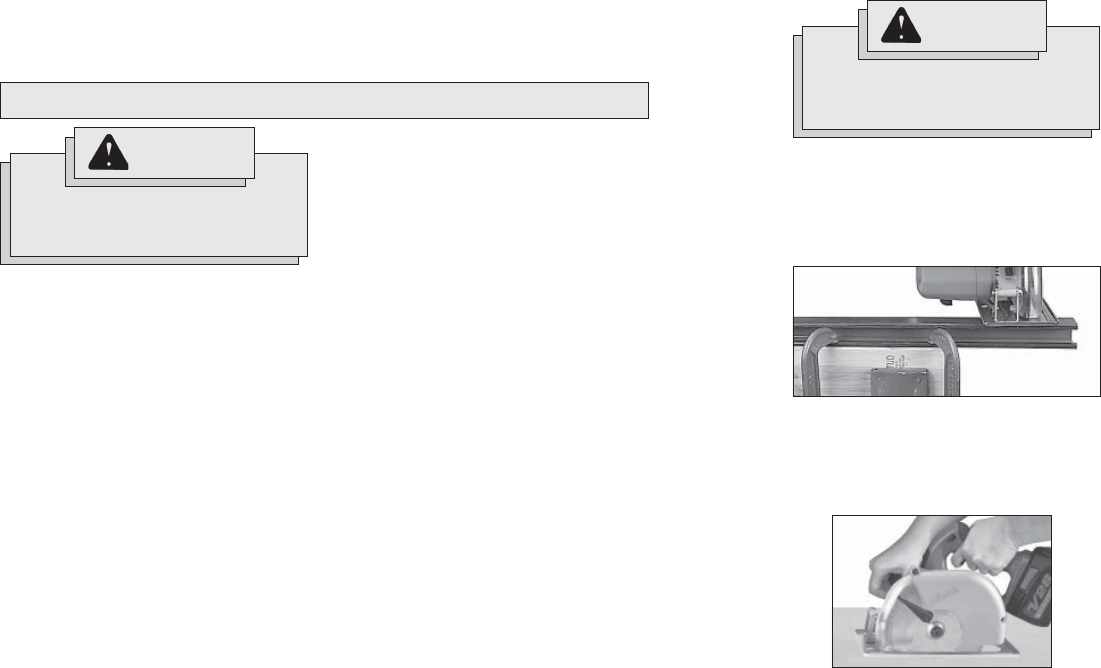
10 11
on the workpiece. The blade should be
just above cutting line, but not touching
it. Raise the lower guard using the lower
guard lever.
2. To start the saw, push the lock-off button
down while pulling the trigger. Allow the
motor to reach full speed before begin-
ning cut. Using the front of the shoe as
a hinge point, gradually lower the back
end of the saw into the workpiece. Re-
lease the lower guard lever and grasp
the front handle.
WARNING
To reduce the risk of injury, use only
specifi cally recommended accesso-
ries. Others may be hazardous.
OPERATION
Causes and Operator Prevention of
KICKBACK:
KICKBACK is a sudden reaction to a
pinched, bound or misaligned saw blade,
causing an uncontrolled saw to lift up and out
of the workpiece toward the operator.
When the blade is pinched or bound tightly
by the kerf, or cutting slot, closing down, the
blade stalls and the motor reaction drives the
unit rapidly back toward the operator.
If the blade becomes twisted or misaligned
in the cut, the teeth at the back edge of the
blade can dig into the top surface of the wood
causing the blade to climb out of the kerf and
jump back toward operator.
KICKBACK is the result of tool misuse and/or
incorrect operating procedures or conditions
and can be avoided by taking proper precau-
tions as given below:
1. Maintain a fi rm grip with both hands
on the saw and position your body
and arm to allow you to resist KICK-
BACK forces. KICKBACK forces can
be controlled by the operator, if proper
precautions are taken.
2. When blade is binding, or when inter-
rupting a cut for any reason, release
the trigger and hold the saw motion-
less in the material until the blade
comes to a complete stop. Never
attempt to remove the saw from the
9. Be cautious of pitchy, knotty, wet or
warped stock. These are most likely to
create pinching conditions and possible
KICKBACK. Do not rip warped lumber.
Avoid cutting nails.
10. Stay alert. Any distraction can cause
twisting or binding. Repetitive cuts may
lull the user into careless movements.
work or pull the saw backward while
the blade is in motion or KICKBACK
may occur. Investigate and take cor-
rective actions to eliminate the cause
of blade binding.
3. When restarting a saw in the work-
piece, center the saw blade in the
kerf, or cut, and check that saw teeth
are not engaged into the material. If
saw blade is binding, it may walk up or
KICKBACK from the workpiece as the
saw is restarted.
4. Support large panels to minimize
the risk of blade pinching and KICK-
BACK. Large panels tend to sag under
their own weight. Supports must be
placed under the panel on both sides,
near the line of cut and near the edge
of the panel.
5. Do not use dull or damaged blades.
Unsharpened or improperly set blades
produce narrow kerf causing excessive
friction, blade binding and KICKBACK.
6. Blade depth lever must be tight and
secure before making cut. If blade
adjustment shifts while cutting, it may
cause binding and KICKBACK.
7. Use extra caution when making a
“Pocket Cut” into existing walls
or other blind areas. The protruding
blade may cut objects that can cause
KICKBACK.
8. Set the depth of cut for no more than
1/8" to 1/4" greater than the thickness
of the stock. The less blade exposed,
the less chance of binding and KICK-
BACK. Before cutting, be sure depth
and bevel adjustments are tight.
General Operation
Always clamp the workpiece securely on a
saw horse or bench (Fig. 10). See “APPLICA-
TIONS” for the correct way to support your
work in different situations.
Fig. 10
WARNING
To reduce the risk of injury, wear
safety goggles or glasses with side
shields.
1. Draw a cutting line. Place the front of
the shoe on the edge of the workpiece
without making blade contact. Hold
the handle with one hand and the front
handle with the other (Fig. 11).
2. Line up the sight line with your cutting
line. Position your arms and body to
resist KICKBACK.
3. To start the saw, push the lock-off button
down while pulling the trigger. Allow the
motor to reach full speed before begin-
ning cut.
Note: LED comes on when the lock-off
button is pushed down.
4. While cutting, keep the shoe fl at against
the workpiece and maintain a fi rm grip.
Fig. 11
3. When the shoe rests fl at against work-
piece, advance the saw to the far corner.
Release the trigger and allow the blade
to come to a complete stop before re-
moving it from workpiece. Repeat the
above steps for each side of the open-
ing. Use a Sawzall
®
reciprocating saw,
jig saw or small hand saw to fi nish the
corners if they are not completely cut
through.
Do not force the saw through the work-
piece. Forcing a saw can cause KICK-
BACK. Use a light, continuous pressure
to make the cut while following the cut
line through the transparent guard or
sight line.
5. If making a partial cut, restarting in
mid-cut or correcting direction, allow
the blade to come to a complete stop.
To resume cutting, center the blade in
the kerf, back the saw away from cutting
edge a few inches, push the lock-off
button down while pulling the trigger and
re-enter the cut slowly.
6. If the saw binds and stalls, maintain
a fi rm grip and release the trigger im-
mediately. Hold the saw motionless in
the workpiece until the blade comes to
a complete stop.
7. After fi nishing a cut, be sure the lower
guard closes and the blade comes to a
complete stop before setting the saw
down.
Overload Protector
The overload protector automatically turns off
the tool when the motor is overloaded. The
tool can become overloaded when using a
dull blade or cutting materials too quickly. To
prevent the overload protector from activat-
ing, always use a sharp blade and follow the
cutting instructions under the "Applications"
section. Do not attempt to defeat or override
the overload protector.
If the tool turns off automatically:
1. Release the trigger.
2. Remove the blade from the workpiece.
3. Reset the overload protector by pushing
in the button.
Note: If the tool does not start after push-
ing the button, allow the tool to cool for
a few minutes and try again.
4. Allow the tool to run under no load to
ensure the tool has properly cooled.
5. Resume the cut. When restarting a saw
in the workpiece, center the saw blade
in the kerf, or cut, and check that saw
teeth are not engaged into the material.
If saw blade is binding, it may walk up or
KICKBACK from the workpiece as the
saw is restarted.



